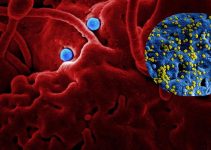Ovarian cysts are usually caused by a build-up of fluid around the ovaries, which can cause:
- Abdominal pain
- Bloating, and
- Lower back pain
- And more…
Ovarian cysts are generally harmless, but sometimes they can be cancerous.
Learn more about ovarian cysts, symptoms, types, prevention, and how they can lead to complications.
What Are Ovarian Cysts?

The female reproductive system consists of ovaries located on both sides of the uterus (in the lower abdomen).
Women have two ovaries that produce eggs and hormones such as estrogen and progesterone.
Sometimes a cyst can develop in one of the ovaries. Most women develop at least one cyst in their lifetime. Cysts usually do not cause symptoms.
Symptoms of Ovarian Cyst
In general, ovarian cysts are asymptomatic. However, they can cause particular symptoms such as:
- Nausea
- Vomiting
- Pelvic pain during or before the menstrual cycle
- Abdominal swelling
- Painful defecation
- Painful intercourse
- Tenderness in the breasts
- Pain in the lower back or legs
- Fever
- Fast breathing
- Severe pelvic pain
- Fainting
If symptoms from 8 to 11 appear, it is essential to see a doctor as they may indicate a torsion of the ovary or rupture of the cyst.
Types of Ovarian Cysts
The most common ovarian cysts are the functional cyst, which can be follicular or corpus luteum. However, there are other types of cysts, such as dermoid cysts or endometrial cysts.
Follicle Cyst
The follicle, located in the ovaries, is the sac in which the egg grows during the menstrual cycle. In general, this follicle breaks, and the egg is released.
However, the follicle may not break open. In this way, the fluid that is inside it can form an ovarian cyst.
Corpus Luteum Cyst
The most common is that the follicular sac dissolves after expelling the egg.
However, when this does not happen, a corpus luteum cyst can form due to an accumulation of fluids within the sac.
There are other types of ovarian cysts such as:
- Cystadenomas: cystic growths that develop on the outer surface of the ovaries. They are not carcinogenic.
- Dermoid cysts: sac-like cysts that grow in the ovaries but contain fat, hair, or other tissue.
- Endometriomas: a cyst that grows when a tissue that normally grows in the uterus develops outside it and clings to the ovaries.
On the other hand, polycystic ovary syndrome is a condition that causes the ovaries to contain numerous cysts. If left untreated, this condition can lead to infertility in women.
Ovarian Cyst Complications
Although it is not common, on certain occasions, a mass of cancerous ovarian cysts can develop.
Also, a rare complication is an ovarian torsion that happens when a large cyst causes the ovary to tighten or move from its original position, causing the blood supply to cut off.
Cyst rupture is also rare. However, if left untreated, it can lead to infection and be life-threatening.
Diagnosing an Ovarian Cyst
Your doctor can use pelvic exam routines to detect an ovarian cyst. Your doctor may notice swelling in your ovary and order an ultrasound test.
The ultrasound test is used to determine the cyst’s location, size, shape, and composition.
Other tools used to diagnose an ovarian cyst are:
- MRI: a test that uses magnetic fields to reproduce images of internal organs.
- CT Scan: tool used to create transverse images of organs.
- Ultrasound device: device used to visualize the ovary.
Treatment for Ovarian Cyst
If the cyst does not shrink or go away, your doctor may recommend the following treatments.
Birth Control Pills
Birth control pills are used to slow down ovulation and prevent the growth of new cysts. In addition, oral contraceptives help reduce the risk of ovarian cancer.
Laparoscopy
If the cyst is found to be cancerous, the doctor can remove it through a laparoscopy. It is a small incision that is made near the navel to remove the cyst.
Laparotomy
If the cyst is large, the doctor can remove it through an incision in the abdomen. Then a biopsy of the cyst is done to determine if it is carcinogenic or not. If positive, a hysterectomy can be performed to remove the ovaries.
Ovarian Cyst Prevention
The most important thing is to go to the doctor for regular gynecological exams. An early diagnosis can help reduce complications.
In addition, you must alert your doctor if you have the following symptoms:
- Lack of appetite
- Abdominal bloating
- Unexplained weight loss
- Continuous pelvic pain
- Changes in your menstrual cycle
What’s the long-term outlook?
As for premenopausal women, the outlook is good. In general, the cysts disappear on their own.
However, recurrent cyst development or hormonal imbalances can lead to infertility if left untreated.
On the other hand, if the cyst grows after menopause, your doctor may recommend surgery to remove or examine it. Although not typical, it is essential to note that the risk of cancerous ovarian cysts is higher after menopause.





